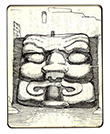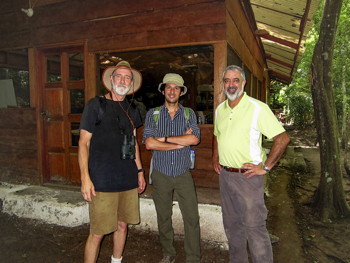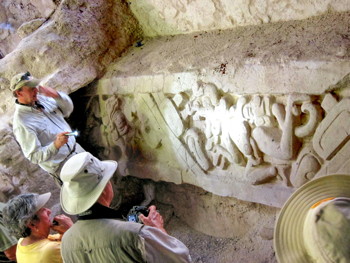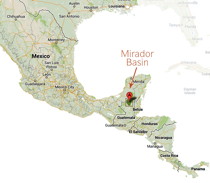IN THE FIELD
Cornellians help uncover and preserve 'The Lost City'
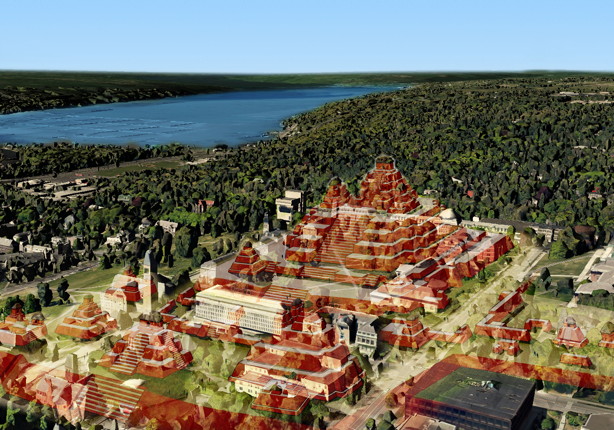
La Danta Pyramid Complex superimposed over Cornell's Arts Quad to show its relative size. La Danta image: 5W Infographics/Pedro Velasco.
Peter D. Gerakaris '03 traveled with Mark Gibian '77 to the El Mirador architectural site in summer 2013, where Cornellians are working with an archaeological team to implement environmental conservation with help from the Guatemalan government.
When fellow Cornellian artist-adventurer Mark Gibian approached me about trekking through the Guatemalan jungle to the "Lost City" of El Mirador last year, it took little arm-twisting to get me to agree. We would reconnect with Mark's friend, archaeologist Kevin Johnston '77, who was working in the phenomenal sites and would help us understand what we were seeing. This was going to be the trip of a lifetime. Sketch of a giant stucco mask by Peter Gerakaris. See larger image With our guide and eight mules, we embarked on a 10-day trek in July 2013 through the Mirador Basin in the Mayan Biosphere Reserve. Close calls with venomous pit vipers, resilient insects, unruly mules, machine-gun armed militia, and territorial spider monkeys were recurring themes on our 100-mile hike through virgin biosphere. One midnight, on a seemingly endless walk through labyrinthine bajos (swamps), we found ourselves in waist-deep water in total darkness during a torrential downpour. Another day, I was thrown from a galloping mule into a tree, then dragged along the rainforest floor until our guide disentangled me. This colossal Maya site has only recently been significantly excavated; it remains mostly covered by dense jungle. Considered the "Cradle of Maya Civilization," the Mirador Basin had spiritual significance for the Maya and once boasted some of the largest cities in the world. Archaeologists have mapped 51 ancient cities in the basin over 20 years – an arduous process in the rainforest. Working with the American nonprofit Foundation for Archaeological Research and Environmental Studies, Johnston helps manage one of the world's largest archaeological enterprises while contributing expertise in Mayan epigraphy. "My job is to estimate the city's ancient population by finding and excavating the houses of farmers and workers," Johnston says. "With these data, I hope to assist the project in establishing the true demographic density of the city." Mark Gibian '77, Peter D. Gerakaris '03 and Kevin Johnston '77 at El Mirador Project camp. Image: provided. See larger image Project director Richard Hansen lectures about the Acropolis frieze. See larger image The Mirador Basin Project is a beehive of activity by archaeologists, anthropologists, architects, historians, surveyors, environmentalists, botanists, entomologists, biologists, geologists and artists. Likewise, hundreds of former chicleros (chicle gatherers), xateros (floral palm collectors) and even huecheros (tomb-looters) find legal employment with the project while receiving specialized training and education. "The Mirador Basin sites demonstrate the power and majesty of what may have been the first state-level society in the Western Hemisphere," says Richard Hansen, a Maya archaeologist who has spearheaded the Mirador Basin archaeology programs for more than 25 years. New artifacts, such as giant painted stucco heads, triadic temple complexes, stucco friezes and ceramics are unearthed daily. These and many other artifacts illuminate the immensity of Preclassic (1000 B.C.–150 A.D.) Maya civilization. Hansen works to protect Guatemala's vast rainforest preserve. Teeming with life, the Mirador Basin is one of the last large tracts of rainforests in the Americas and a haven for unique and endangered flora and fauna, including jaguars, rare orchids and medicinal plants. Hansen envisions Mirador as a major ecological and archaeological tourism destination – akin to nearby Tikal, another ancient city whose sites and ecosystem are protected. The Mirador Basin Project argues for a controlled, sustainable approach to tourism that would protect the rainforest and provide superior employment opportunities for the surrounding communities while funding excavations and restoration. "The Mirador Basin sequesters over 50 million tons of carbon from the atmosphere with resources valued at over $250 million today," says environmental economist Brent Sohngen '91 of Ohio State University. Mirador Basin shown on Central America map. See larger image Evidence suggests the decline of the Mirador Maya can be attributed to human over-depletion of natural resources. To manufacture lime for the stucco and plaster to surface their temples, causeways and plaza floors, the Maya burned vast swaths of rainforest. A growing community of alumni foresee the benefits of future Cornell involvement with the Mirador Basin project – where students and faculty in many fields could work. Already, Cornell Lab of Ornithology scientists have conducted rapid bird surveys in El Mirador and Tintal. Much of the financing for Mirador Basin conservation and investigation was led by Jeff Morgan '84, executive director of the Global Heritage Fund, which provides funding to protect and conserve cultural heritage sites and ecosystems. Josephine Thompson, MRP '97, a Foreign Language and Areas Studies fellow and Einaudi Center scholar, contributes her expertise in mapping technologies and regional planning. Robert Berry, a longtime supporter of the Cornell Lab of Ornithology, has contributed substantially to the protection of primal bird habitat in the basin. The current season of fieldwork (July–August) can only be sustained for an intensive month and a half with current funding. As this article was being written, a new road was being cut – the first of its kind – that penetrates the otherwise protected biosphere rainforest, often the first step toward rainforest destruction. A call to action and intervention is more urgent and critical than ever.